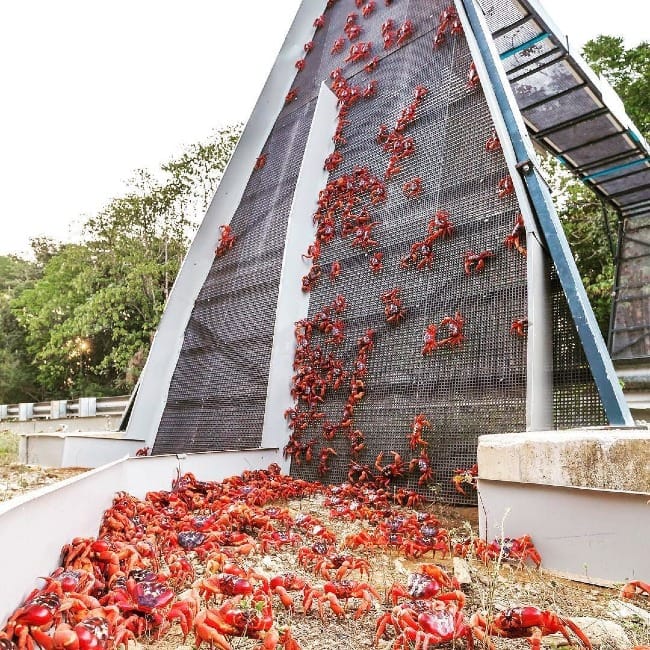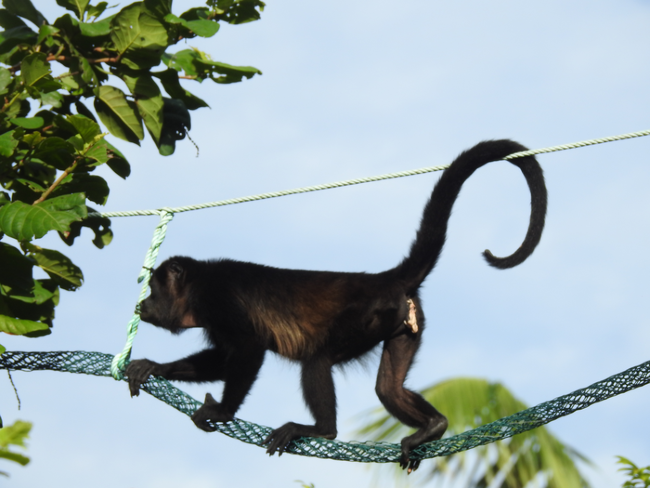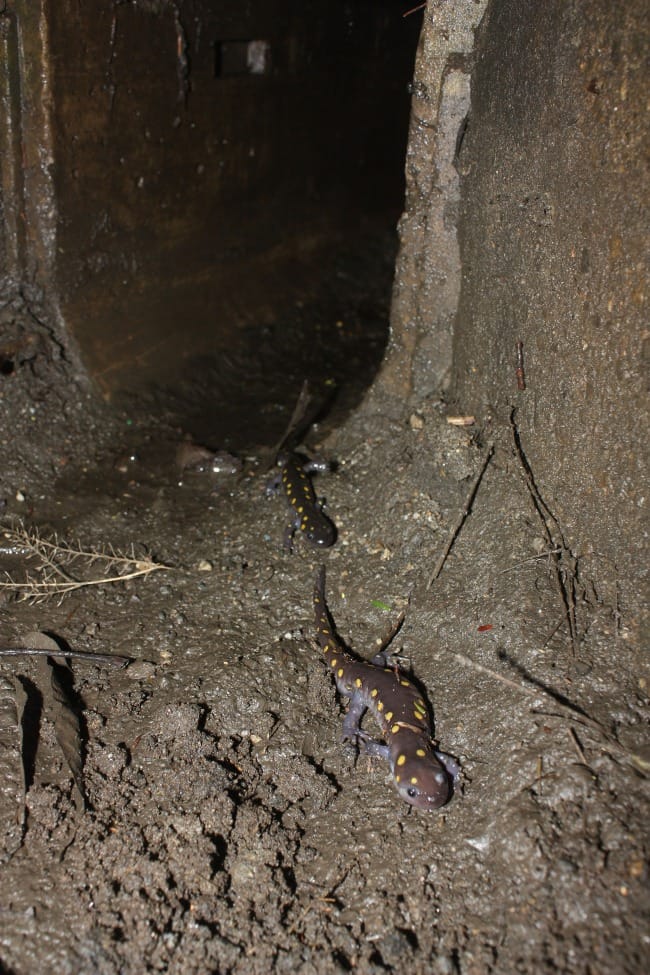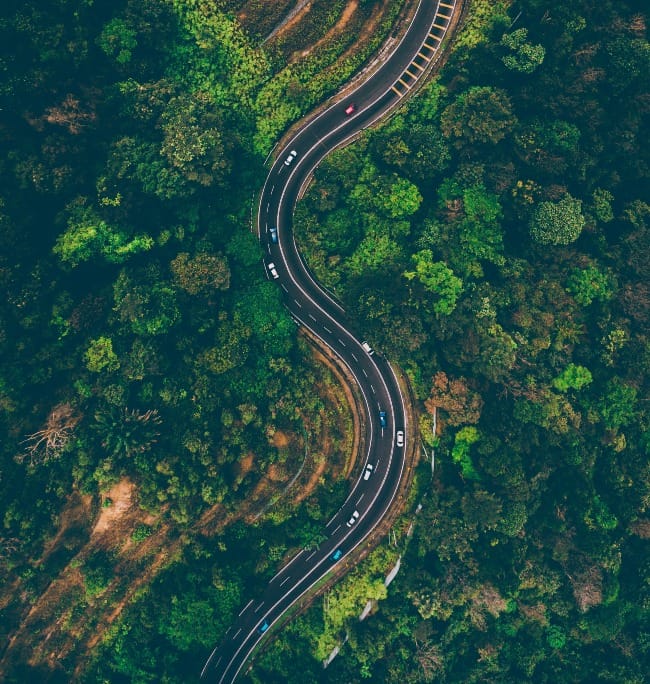Since the first wildlife crossing was built in France in the 1950's by hunters to guide deer, the idea has continued to spread. As roads have widened and lengthened, and traffic has proliferated and sped up, nonhuman creatures have struggled to survive and thrive with splintered habitats, dangerous migration paths, and collisions where they almost always come out on the losing end.

European countries have been leaders in the area of wildlife crossings. The Netherlands alone has built over 600 ecoducts, both underpasses and overpasses, to support and boost the country's badger population—an effort which has been successful as those numbers have risen.
This sort of effort is happening around the world, aimed at both specific creatures and general populations. Elephants, bears, turtles, alligators, frogs are just a sprinkling of the species who are specifically targeted with particular crossing structures.

In Australia, the well-known Christmas Island crab crossings enable hordes of crabs to get across the road safely as they crawl toward the ocean en masse to mate and then release their eggs.

In other places, such as Costa Rica's rainforests, natural solutions have been found. Leaving natural tree canopies in place when roads are being developed can create canopy bridges of two or more large trees on either side of the road so that arboreal creatures, especially primates, can move safely from one part of the forest to another, even with a road in the way. Creating rope bridges in places where there are gaps in the canopy provides additional safe crossing points. The crossings can be as simple as a rope attached to trees at both ends, depending upon the animals that will be using it.

Creative wildlife crossings abound as do the stories of human assistance. In the early 1980’s Amherst, Massachusetts neighbors formed bucket brigades on the late March or early April nights when temperatures rose above 40° and sent salamanders out of their winter burrows to cross the road to nearby ponds that were their mating grounds. The bucket brigades carried hundreds of spotted salamanders to their longed-for destination. The British Floral Preservation Society and ACO Polymer (a drainage company in Germany), heard about the salamanders and, working with local organizations, piloted an experimental tunnel project to provide a safe passage under the roadway for salamanders and other amphibians. The tunnels worked—though bucket brigades still operate in areas where the salamanders don't have easy tunnel access.
Another fascinating origin story from the U.S. happened in 1989, as the department of transportation planned to expand Highway 93 in the Flathead area of Montana with the aim to make the unsafe highway safer for drivers. Because it ran through the Flathead Indian Reservation, as a sovereign nation, they had the power to stop the project. Deeply concerned for vulnerable humans and other creatures, the Salish and Kootenai used this political power to have their voices and knowledge heard and heeded. The result was the inclusion of 42 wildlife crossings into the highway plan. The plan included the statement (and the perspective) that, “the road is a visitor and that it should respond to and be respectful of the land and the Spirit of Place.”
In the United States, wildlife crossings have lagged behind many other parts of the world, but the passage of the 2021 $1.2 trillion IIJA Bill included $350 million slated for the construction of safer ways for animals to cross busy roads.

There remain words of caution from scientists, however, who emphasize that wildlife crossings are just a single piece of what is needed to reconnect wildlife populations. If the promise of wildlife crossings is used to push through new roads in sensitive areas where there shouldn't be roads at all, the positive environmental value will be far outweighed by the cost to the animals. Such crossings improve a bad situation, but don't make a bad situation good. Better by far is to plan in such a way that these negative effects are minimized.
As environmentalist Trisha White says, “I want everyone to be super excited about wildlife crossings, but I don’t want people to forget that a wildlife crossing is like a Band-Aid.” The structures, she emphasized, can only fix a small part of the road’s damage to wildlife habitat. “The road,” she said, “is like a wound.”
Is there a way you might help your nonhuman neighbors move more easily through and around your home? Do you see places where other creatures encounter difficult obstacles you could help remove? As an example, an earlier post by Vidhya Chintala on The Ecological Disciple highlighted ways to warn birds away from our obstructing windows. You might take a walk around your home and neighborhood, looking for places and things that currently hinder the movement of creatures from one area to another and brainstorm ways to change those.
Feel free to contact me directly at info@circlewood.online.
Louise
If you want to hear more about wildlife crossings, here are two links for you to explore. The first one tells the story of the key role of indigenous people in creating the network of Montana Flathead wildlife crossings. The second shares what happened in Washington State when a crossing was built across a major highway.
An invitation to readers! If you've seen something recently that intrigued or amazed you enough to take a photograph, draw a picture, or write a (short) poem, send it to me by April 10th so that I can include it in an upcoming column bringing these artistic responses together. Along with your photo, picture, or poem, I would love to include a sentence or two from you introducing your piece.
